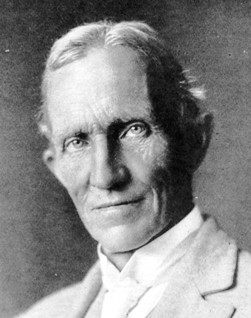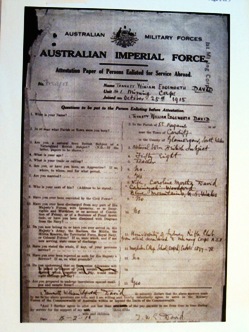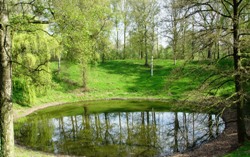
John Dixon* considers the contribution of Welsh geologist William Edgeworth Tannat David to the grisly business of trench warfare
Tannatt William Edgeworth David (left) was born at the Rectory in St Fagans, near Cardiff, on 28 January 1858. In 1876 he entered New College Oxford to read Classics and graduated 1880. Following his studies he returned to Cardiff, where he became interested in geology. By 1882 he was considered sufficiently expert to present papers on the glaciation of South Wales. A year later his results were published by the Geological Society of London.
In 1882 David took a post as Assistant Geological Surveyor in the New South Wales Geological Survey. He discovered the coal seams in the Hunter Valley, which are still producing coal today. By 1891 he was Professor of Geology at the University of Sydney - then a department of just one! Soon, his course became very popular and the department grew. He also gave public lectures on geology and took science to the ordinary people of Sydney His field trips were well attended and attracted scientists from other fields. It was during these years that the brown felt hat he always wore became famous among his students. The “Prof” was hardly ever seen without it!
In 1907 he persuaded Ernest Shackleton to let him take charge of the scientific aspects of his Antarctic expedition. By this time David was 50; but he managed to survive the rigours of a long Antarctic expedition with much younger men. He was an active member of the team leading the first ascent of Mount Erebus, an active volcano - and what geologist could resist that? Also, he was one of a party of three to reach the vicinity of the South Magnetic Pole. For these exploits he was made a Companion of the Order of St Michael and St George and awarded the King’s Polar Medal.
RETURN FROM ANATARCTICA
Following his return from Antarctica David’s fame as a public speaker grew. He was by now Australia’s most famous scientist; already known by academia worldwide, the Antarctic expedition raised him to celebrity status. Nevertheless, he never lost sight of his teaching and research, and remained involved with august bodies such as the Royal Society and the Geological Society of London.
 At the outbreak of the Great War David (right - David's Attestation Papers, from when he joined up - 'Occupation - teacher...) was 56 years old and no-one expected him to become involved with matters military. But he not only wanted to be involved - he wanted to make a real contribution. He suggested to the Australian Minister of Defence that a Tunnelling Battalion be formed for service in Europe. As a geologist who had worked in mining, he saw the usefulness of both in the war. His idea was approved and he recruited men capable of being tunnellers (managing to land himself a commission as Major in the process).
At the outbreak of the Great War David (right - David's Attestation Papers, from when he joined up - 'Occupation - teacher...) was 56 years old and no-one expected him to become involved with matters military. But he not only wanted to be involved - he wanted to make a real contribution. He suggested to the Australian Minister of Defence that a Tunnelling Battalion be formed for service in Europe. As a geologist who had worked in mining, he saw the usefulness of both in the war. His idea was approved and he recruited men capable of being tunnellers (managing to land himself a commission as Major in the process).
On arrival in France, the battalion was restructured leaving David without a job. The officer in charge admitted that he had no idea how useful a geologist could be in spite of the fact that the British Army already had one geologist working on the front - Captain W B King of the Royal Welsh Fusiliers. David was given a free-ranging role along the front, reporting to the Inspector of Mines and working closely with King.
GROUNDWATER
 David studied groundwater levels in areas of offensive mining and produced charts and tables predicting its occurrence. This helped to make mining more direct, efficient and safer. He noted the delay between storms and the changes in level of groundwater so that he predicted when miners should be taken out of galleries that were likely to become flooded.
David studied groundwater levels in areas of offensive mining and produced charts and tables predicting its occurrence. This helped to make mining more direct, efficient and safer. He noted the delay between storms and the changes in level of groundwater so that he predicted when miners should be taken out of galleries that were likely to become flooded.
Image, left: David's geological cross-section at Wytschaete, Lille. Known to troops as 'Whitesheet', this village lies about a mile north of Messines, on the main N365 road from Ypres to Armentieres.
An investigation into a well that had suddenly dried at Vimy on 25 September 1916 nearly brought David’s war to an abrupt end. He was being lowered down the well by windlass when it broke. He plunged 70 feet, bouncing off the sides of the well as he went. He suffered a head wound as well as internal injuries, but remained conscious and was able to hail an officer at the top and ask a bandage be sent down to him. A doctor attended him at the bottom of the shaft before he was lifted. David wrote:
“He bound up my head, and helped to fix me on the rope, and then just as they were about to start to pull me up I sung out to them to pull me up slowly so that I might have the chance of examining the chalk in the sides of the well. As a matter of fact, this was rather bravado on my part because I wasn’t at all sure but what I might suddenly become unconscious and drop off the rope.”
His bloodied state attracted attention from soldiers in the trench with queries such as “Shrapnel?” to the stretcher bearers but on hearing he had fallen down a well there was little interest – the infantryman of 1916 had seen too much death and destruction to give an aged officer who had fallen down a well a second thought.
When David returned to the Front he worked on the Messines mining operations, General Harvey crediting him with their success. However, David always maintained that Harvey was responsible for the concept and planning of the mines. David was involved in some of the major decisions for later mines, such as the Boyle’s Farm mine, where problems caused by a fault were resolved by him, thus allowing the mine to be finished on time. David’s energy, knowledge of geology and experience in mining had pushed the project forwards fast enough to ensure success.
The success of the mining at Messines prompted the Germans to order all their geologists over 40 back to Berlin and all those under 40 to the front. General Harvey is recorded as saying “The moral perhaps is that it is better to employ two first class geologists like our own than 20 second-class or German ones”.
Following Messines David was kept busy demonstrating how best to build dugouts in clay soils around Ypres and identifying aggregates for making concrete. During the final advance, both David and King - with the help of Tasmanian geologist Loftus Hills - were kept busy finding water for the advancing troops and ensured its supply.
ROYAL ENGINEERS
 At the end of the war David and King compiled Work of the Royal Engineers in the European War, 1914 -1919; Geological Works on the Western Front which was completed in 1922. This volume carries no authors’ names but it is generally identified now as being the work of David with a significant contribution from King. For his service in the Great War David was awarded the Distinguished Service Order (DSO), Mentioned in Despatches on three occasions and created KBE. The work unseen by the troops and understood by only a few ‘in the know’ was certainly appreciated at the highest level.
At the end of the war David and King compiled Work of the Royal Engineers in the European War, 1914 -1919; Geological Works on the Western Front which was completed in 1922. This volume carries no authors’ names but it is generally identified now as being the work of David with a significant contribution from King. For his service in the Great War David was awarded the Distinguished Service Order (DSO), Mentioned in Despatches on three occasions and created KBE. The work unseen by the troops and understood by only a few ‘in the know’ was certainly appreciated at the highest level.
Image: The 'Catterpillar Crater', Hill 60, today. Photo: John Dixon.
Following the war David, now 61, returned to academic life in Sydney. He was still involved in Antarctic exploration and collaborated with Sir Douglas Mawson on his later exploits. By 1934 he was actively researching his massive work The Geology of the Commonwealth of Australia when he slipped and fell getting off a tram in Sydney. He never recovered and died shortly afterwards. There followed a State funeral. In the press reports that followed one journalist affectionately coined the phrase “The knight in the old brown hat”.
Reference
- Branagan D (2005) TW Edgeworth David, A Life. National Library of Australia, Canberra.
More information on the battlefields referred to, including Messines and Hill 60, may be found at www.ww1battlefields.co.uk.
* Dr John Dixon is Principal Geotechnical Engineer, Mining, Coffey Geotechnics Limited.